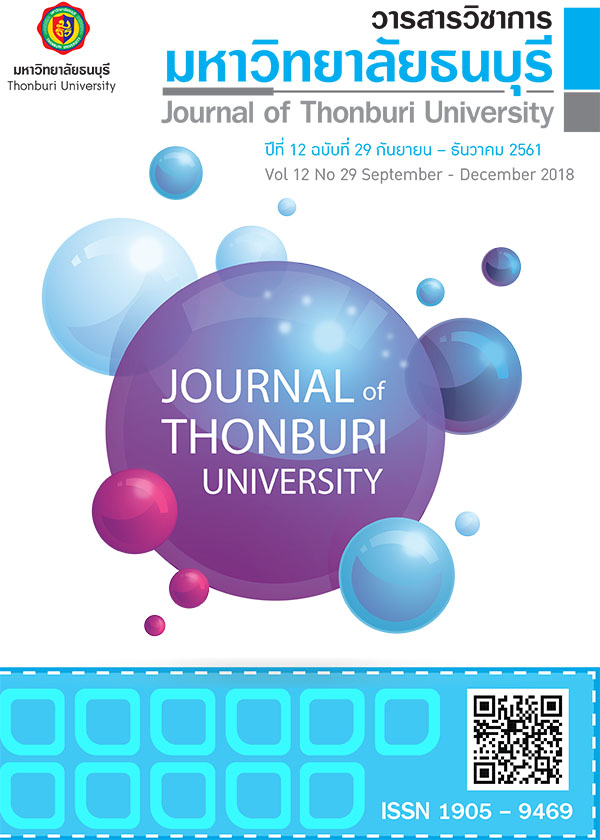SAMPLING AND INTEGRATION BASED ON MIXED METHODS RESEARCH
Main Article Content
Abstract
Abstract
This article presents the topic of sampling and integration based on mixed methods research by explaining sampling including sampling in quantitative research, sampling in qualitative research, and sampling mixed methods. For a sampling of the mixed methods research. There will be different depending, on the research of mixed methods. The sampling of mixed methods research illustrated by 4 patterns convergent design, explanatory sequential design, exploratory sequential design and intervention design. The integration of quantitative and qualitative data in mixed methods research is described, beginning from the research quality followed by the quantitative research. Integrating quantitative and qualitative data in the form of tables and graphs called “joint display”, which saw the mixed sample in the research methodology are presented. Presentation and methods of integrating quantitative and qualitative research methodology combine the clarity. This knowledge can be applied in the design of the sample mixed research methods. Quantitative and qualitative data are combined in mixed methods research correctly, according to the research mixed. It can be used as a skill to enhance the view of the data to be more diverse, and to maximize the benefits of research to the mixed methods.
Keywords: Sampling, Integration, Mixed Methods Research
Article Details
References
โกศล มีคุณ. (2551). การวิจัยเชิงปริมาณที่เสริมด้วยการวิจัยเชิงคุณภาพ. วารสารพัฒนาสังคม. 10(1):27-40
ประไพพิมพ์ สุธีวสินนนท์ และประสพชัย พสุนนท์. (2559, ตุลาคม–ธันวาคม). กลยุทธ์การเลือกตัวอย่างสำหรับการวิจัยเชิงคุณภาพ. วารสารปาริชาต มหาวิทยาลัยทักษิณ 29(2).
ผ่องพรรณ ตรัยมงคลกูล;และ สุภาพ ฉัตราภรณ์. (2549). การออกแบบการวิจัย. พิมพ์ครั้งที่5. กรุงเทพฯ: สำนักพิมพ์มหาวิทยาลัย เกษตรศาสตร์.
พวงผกา คงวัฒนานนท์. (2556). การใช้วิธีวิจัยแบบผสมผสานวิธีเพื่อสร้างความน่าเชื่อถือของงานวิจัยทางสุขภาพ. วารสารวิทยาศาสตร์และเทคโนโลยี, 23 (ฉบับพิเศษ), 648-657.
วัลนิกา ฉลากบาง. (2560, พฤษภาคม-สิงหาคม). การวิจัยแบบผสมผสาน. วารสารมหาวิทยาลัยนครพนม 7(2).
วิโรจน์ สารรัตนะ. (2545). การบริหาร หลักการ ทฤษฎี ประเด็นทางการศึกษาและบทวิเคราะห์องค์การศึกษาไทย. พิมพ์ครั้งที่ 3. กรุงเทพฯ: พิมพ์พิสุทธ์.
สุชาติ ประสิทธิ์รัฐสินธุ์;และ กรรณิการ์ สุขเกษม. (2547). วิธีวิทยาการวิจัยเชิงคุณภาพ :การวิจัย ปัญหาปัจจุบันและการวิจัยอนาคตกาล. กรุงเทพฯ: เฟื่องฟ้า พริ้นติ้ง.
Anthony J. Onwuegbuzie, and Kathleen M. T. Collins. (2007). A Typology of Mixed Methods Sampling Designs in Social Science Research. The Quality Report, 12(2): 281-316.
Bryman, A. (2006). Integrating quantitative and qualitative research: How is it done?. Qualitative Research, 6, 97-113
Creswell, J. W. & Clark, V.P. (2007). Designing and conducting mixed methods research. Thousand Oaks, C.A.: Sage.
Creswell, J. W. (2003). Research Design: Qualitative, Quantitative, and Mixed Methods Approaches. 2nded. California: Sage.
Creswell, J. W. (2012). Planning, Conducting, and Evaluating Quantitative and Qualitative Research. 4thed. University of Nebraska–Lincoln.
Creswell, J. W. (2013). Qualitative inquiry & research design: Choosing among five approaches. Los Angeles: Sage.
Creswell, J. W. (2015). A Concise Introduction to Mixed Methods Research. Thousand Oaks, CA: Sage.
Fowler, F. J., Jr. (2008). Survey research method. 4thed. Thousand Oaks, CA: SAGE.
Greene JC, Caracelli VJ, Graham WF (1989). Toward a conceptual framework for mixed–method evaluation designs. Educ. Eval. Policy Anal., 11: 255–274.
Lipsey, M. W. (1990). Design sensitivity: Statistical power for experimental research. Newbury Park,CA: SAGE.
Morse, J.M., (1991). Approaches to qualitative- quantitative methodological Triangulation, Nurs. Res.40: 120-123.
Punch, K.F. (2003). Survey research: the basics. California: Sage Publications.
Punch, K.F. (2005). Transformations Process: quantitative and qualitative approaches. 2nded. Sage.
Trochim, W. M. (2002). The research methods knowledge base. 2nded. Retrieved September 16, 2017, from http://trochim.human.cornell.edu/kb/index.htm.
Translated Thai References
Prasithrattasin, S.;& Sukkasem, K. (2004). Qualitative research methods: research Current issues and research in the future tense. Bangkok: Fuengfah printing. (in Thai)
Sarnrattana, V. (2002). Management principles, theories and issues in educational study and analysis Organization studies, Thailand. 3rded. Bangkok: printer, Pisut. (in Thai)
Trimongkolkul, P.;& Chattraporn, S. (2006). Research design. 5thed. Bangkok: Kasetsart University Publisher. (in Thai)
Kongvattananon, P. (2013). Using Mixed Method for Creditability in Health Science Research. Journal of Science and Technology; 23 (Special ed.), 648-657. (in Thai)
Meekhun, K. (2008). Quantitative research supplemented with qualitative research. Journal of Social Development. 10 (1): 27. (in Thai)
Sutheewasinnon, P;& Pasunon, P. (2016, October-December). Sampling Strategies for Qualitative Research. Journal of Parichat Thaksin University. 29(2). (in Thai)
Chalakbang, W. (2017, May-August). Mixed Methods Research. Journal of Nakhon Phanom University. 7(2). (in Thai)
Chanasith, K., Pasunon, P. and Chantuk, T. (2018, January-April). Analysis of behavior and factors that the choice to purchase ready-to-eat frozen food of students of Rajamangala university of technology phra nakhon. Journal of Thonburi University. 12(27):56-69. (in Thai)

